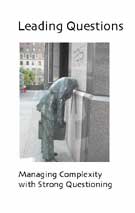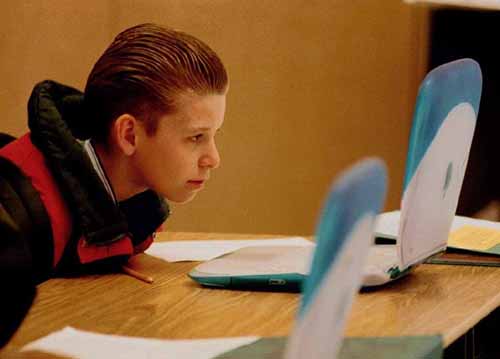
fno.org
|
|
| Vol 17|No 2|November 2007 | |
| Please feel free to e-mail this article to a friend, a principal, a parent, a colleague, a teacher librarian, a college professor, a poet, a magician, a vendor, an artist, a juggler, a student, a news reporter or to anyone else you think might enjoy it. | |
|
|
 |
| Across the land, English and Language Arts teachers are under increased pressure to meet challenging objectives set by state curriculum standards. To meet these thinking, problem-solving and communicating standards, it pays to involve students in seeing how these skills are practiced in the world of work outside of school. As much as possible, it makes sense to involve them in such work, either through internships, visits, interviews or simulations.
This article will outline promising ways to manage learning opportunities of this kind. 1. The Rationale By employing such learning strategies within a real world context, students sharpen their abilities while gaining an appetite for the work at hand. Because they are rooted in the here and now, young ones find the challenges invigorating and intriguing. Caring about the tasks, they invest to a greater degree and emerge with a firmer and deeper grasp of the key concepts. Such is the promise of Fred Newmann's concept of “authentic teaching” that involves students in “authentic intellectual work” outside school. Instead of busy work - repetitive tasks that require little thought and involve mere scooping, smushing, memorizing and regurgitating - Newmann's approach immerses students in challenges that demand imagination, resourcefulness, persistence and stamina. Even though some of these activities may be staged or simulated, they still pass the test of authenticity because they meet the following criteria:
In short, authentic intellectual work passes the test of “so what?” It is meaningful, worthy and generative - in the sense of provoking ongoing growth and development. What are the benefits for teachers? Teachers are promoting learning that increases student productivity, motivation and engagement. Stultifying routines are replaced by activities that spark curiosity while combating adolescent detachment or apathy. The teacher is rewarded with smiles, a forward lean and the satisfaction of witnessing learning infused with energy and enthusiasm.
2. The Strategy The teacher surveys a range of professions and jobs with the idea of identifying situations within each that might require problem-solving, decision-making and powerful communication. It is possible to create a matrix of some 60 or more workplace settings worthy of consideration and then give students some choice across that matrix. Web sites abound offering a rich array of professions and jobs to explore when planning authentic learning experiences.
These sites serve to define the possibilities and the targets. If possible, the teacher and the class will focus on those that offer rich local possibilities, but in some remote regions, it will be necessary to conduct the learning at a distance. Phase One - The class investigates a problem within one job or profession selected in advance by the teacher as a “proving ground” to equip all members for a more independent stage later on when small teams may select from the matrix and conduct authentic work within a single industry or profession. Example: The teacher has selected the regional rural electric cooperative as the target for the first stage because the high school is set in a rural county without many local businesses with ripe opportunities for problem-solving and decision-making. The utility is an important local business that offers some complex and intriguing problems to consider, which the teacher knows from being married to one of the managers. Co-OP Activity One - Visit The teacher arranges for the whole class to visit the Co-Op to learn about the operation. Many of the students will know little more about the Co-Op than its primary Sample Questions
These questions would serve well for a first visit to many work places. Co-OP Activity Two - Interviews Prior to the first visit, students will have little understanding of the organization running the Co-Op, but they soon discover that there are five or six major departments, each of which handles an important aspect of the operation. In-depth interviews follow the first visit, with teams of 3-4 students scheduling appointments outside of the school day to return to the Co-Op. Their main goal is to identify a list of actual issues and problems worthy of authentic work. A class of 30 splits up into 5-6 teams, with each team concentrating on a department. They return to class with a report identifying and defining 2-3 challenges that might be worthy of a project.
Co-OP Activity Three - Simulations and/or Proposals Once the students know the challenges, they may be able to help the Co-Op in real time, creating an actual public service announcement with the high school's TV studio, for example, that the Co-Op gratefully accepts as a public relations gesture to calm down the angry customers, as sons and daughters of customers are seen explaining the Co-Ops challenges while vouching for their sincerity and earnest efforts. In some cases, the workplace being visited may not welcome real student products, but the team can simulate the problem-solving as if they were the PR department and create the video whether it is actually used by the real organization or not. Students are savvy enough to understand that the adult workplace is serious business and cannot allow amateurs to conduct its business. The work will still pass the tests of authenticity mentioned earlier. Co-OP Activity Four - Internships In some cases, members of the class may actually develop a longer term relationship with the business being studied, reporting to work in the afternoons as an intern, working alongside the adults as a member of a team charged with real problem-solving. During the internship, they keep track of their experience in a journal and they collect a portfolio of authentic work products they helped to produce. 3. The Small Team Investigation Stage The first workplace investigation is a shared experience to prepare small teams to conduct a similar investigation of a different business or profession selected from the matrix mentioned earlier. Teams of 4-5 students pass through the same steps but have more choice of what to study. Example 1: A team visits a veterinarian's office and makes a list of the major challenges and issues facing the office. The team then considers which of these challenges would offer the best practice3 of powerful language arts communications skills, whether those be multimedia presentations, a newsletter, displays in the office or scripts for the receptionists to use on the telephone. Once they have identified tasks that seem appealing and feasible, they set about creating work products that will eventually be shared with the veterinarian herself. 4. Other Examples of Authentic Intellectual Work A teacher could create a series of workplace-based scenarios much like the ones described earlier that would be based on the teacher's research instead of requiring the time consuming student field research outlined earlier in this article. Simulations offer many efficiencies and may be created with enough veracity to capture the students' interest and accomplish the authenticity intended by Fred Newmann. There might be one simulation involving the trials and tribulations of a local radio station, another one devoted to a volunteer fire department struggling to maintain adequate staffing in the face of a declining local population and others with a focus on attracting new customers or employees. For these simulations to pass the test of authenticity, they must meet the criteria mentioned in the beginning of this article. Consequences When students are engaged in producing persuasive documents or media presentations, they are demonstrating the capacity to apply what many consider to be 21st century skills to the solution of thorny issues and problems. They are acquiring abilities that will serve them well as adults, and they are doing so in a way that is highly motivating. Resources Five Standards of Authentic Instruction |
|
|
Copyright Policy: Materials published in From Now On may be duplicated in hard copy format if unchanged in format and content for educational, nonprofit school district and university use only and may also be sent from person to person by e-mail. This copyright statement must be included. All other uses, transmissions and duplications are prohibited unless permission is granted expressly. Showing these pages remotely through frames is not permitted. |
|

Info

 mission - the provision of electricity to remote areas. This first visit is meant to serve as a model for visits they may conduct during Phase Two when they will be exploring industries and operations of their choice. The teacher helps students generate good questions prior to the visit so they are not just walking around. They are trying to figure out what are the biggest challenges facing the organization.
mission - the provision of electricity to remote areas. This first visit is meant to serve as a model for visits they may conduct during Phase Two when they will be exploring industries and operations of their choice. The teacher helps students generate good questions prior to the visit so they are not just walking around. They are trying to figure out what are the biggest challenges facing the organization.